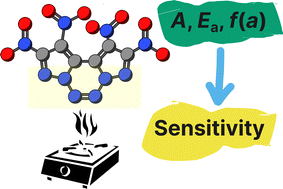Thermal stability of emerging N6-type energetic materials: kinetic modeling of simultaneous thermal analysis data to explain sensitivity trends†
Abstract
A number of new high-performing energetic materials possess explosophoric functionalities, high nitrogen content, and fused heterocyclic blocks. Two representatives of these materials have been synthesized recently, namely, 1,2,9,10-tetranitrodipyrazolo[1,5-d:5′,1′-f][1,2,3,4]-tetrazine (1) and 2,9-dinitrobis([1,2,4]triazolo)[1,5-d:5′,1′-f][1,2,3,4]tetrazine (2). The thermal stability of these energetic materials bearing the N–N–N = N–N–N fragment and three closely related compounds has been investigated for the first time. The thermal decomposition process of analyzed compounds was complicated by the appearance of the liquid phase, sublimation of the material, and autocatalysis by reaction products. In contrast to the traditional approach to the kinetic modeling based on data from either TGA or DSC, we use both signals’ data measured at the same time and perform the joint kinetic analysis using the model-fitting technique to obtain the pertinent kinetic description of the process. Of the analyzed materials, 1 and 2 show the lowest thermal stability in melt with a characteristic rate constant of 2.6 × 10−3 s−1 at 250 °C. The kinetic parameters and calculated detonation performance data were used in the model to describe the mechanical sensitivity. The model output and the experimental friction sensitivity data show a respectable agreement, but more data are required to draw firm conclusions. In general, the provided thermal stability and kinetic data can be used for thermal response and storage modeling of these new N6-type energetic materials. The developed thermokinetic approach, joint model-fitting of several thermal analysis signals, can be applied to other complex thermally induced processes to increase the value and credibility of the kinetic findings.

- This article is part of the themed collection: 2023 PCCP HOT Articles


 Please wait while we load your content...
Please wait while we load your content...